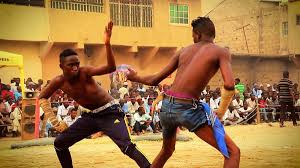Transcending successive generations, dambe, which is a martial art mostly associated with Hausa culture, has perched somewhere between the past and the present.
The game is gradually adjusting its archaic garb and is proving to the world that there is no such thing as absolutely traditional or completely modern in nature at the present time.
- After Daily Trust story, FG suspends sale, activation of SIM cards
- Number of displaced persons surpasses 80m during pandemic – UN
The use of lethal items, like shards of glasses sewn into Kara (rope fighters wind round their hand), that might cause grave bodily injuries and often death has since been abolished.
Based on the profound knowledge of the past, the game is sharply penetrating the modern world and is constituting itself into one of the leading sports in this part of the world.
Dambe is a three-round game without a time limit specification. It is brought to a halt when an official, for a certain reason, calls for it to stop or a rain of punches knocks a fighter to the ground.
The aim of every competitor is to bring (in local parlance “kill”) his opponent into total submission. This is achieved more often than not either through kicks or punches.
Dambe may be a brutal sport that has left many with broken jaws or ribs, scarified faces, bloated temples, swollen brow ridge or missing teeth, but one thing we cannot take away from it is its entertainment function.
War and work songs are very common throughout the Hausa tradition; Dambe is not an exception as it has given rise to special poetry the sound of which accompanying musical instruments are felt but in the marrow.
“Dambe is as old as the Hausa culture itself. It has been the sport, on a par with wrestling (Kokawa), to mark the end of the harvest time. Fishermen would engage butchers to show bravery.
“A warrior would engage another and the winner would emerge after kicking his opponent to the ground,” said a spectator, Habu Dikko.
The promoters
The game is fast giving the receding Ado Bayero Square – once the heart beat of athletics in Kano State – a new life. Everywhere is a sign of hope that the game is there to save the once busiest sports complex in the state.
Dambe Trador, the promoters, have made sure the combat sport, which traces its origin centuries back to the time when butchers and fishermen practiced it to celebrate festivities and show courage, find a perfect place in modernity.
In the same passion as ancient Roman Amphitheater, Kano Dambe Trador stadia (a makeshift stadia) is designed as a freestanding or oval-shaped building fenced with iron sheets, with a central area (the arena) barricade with wooden bars or sand bags.
The chit-chattering spectators crowd over the arena and sit on wooden benches placed upon a raised platform, some on the ground, to give the place an imaginary taste of a typical arena.
The sight is beyond that of fully kitted fighters, hands bound with rope called “Kara”, punches, kicks, or that of spear (the hand used for attack) and shield (the hand used for blocking attacks), it is also that of passion and satisfaction.
“Every sport, be it football or hockey, is traditional in nature, but later on it graduates to something else. Dambe saw the light of the day with its inclusion into Nigerian sports at Imo in 1998.
“We have been working unrelentingly since we came in to make sure the sport gets the attention it deserves in modern-day Nigeria and beyond.
“Many of the fighters have let go of the habit of itinerary fighting because we organize one competition after another and a winner gets a good deal of prize.”
Hundreds of young and old, men and women troop into “Gidan Damben Kano” every afternoon to watch the combat sport.
Persuasion does matter
It is not only to religion or politics “persuasion” is attached; persuasion is one of the key features of the Hausa martial art and the fans take pride in that.
Yet, one needs not belong to Arewa (Jamis), Kudawa or Kuramada persuasions of dambe to be addicted to the game; even people with neutral stand love the game and view it as a shock absorber. There they go to while away their worries.
“I am a Ba’are (Jamis) and I am proud of that. I started watching it when I was young during the reign of the first governor of Kano State, Audu Bako.
“My late father would hold my hand to the ring. Since then I have been watching the game and fast holding onto Arewa as my Dambe persuasion,” said Auwalu Yakubu DanKano.
Fighters have their own chief

Of course, various competitions are organized and played at the Kano Dambe Trador stadia year in year out.
A fighter may crush out one opponent after another to win for instance Ganduje’s cup or any competition of that repute; but that will never make him the chief of dambe.
The traditional title comes with a grand victory in Kano emir’s cup; but the danger is enormous as fighters come from various parts of the country to wrestle it out for the exalted title.
Science and spiritualism adjoined

Any dambe athlete one sees is a warrior who has developed a strong footing in tradition and yet holds fast to technology for survival.
The sponsorship funding is powered by technology as the promoters go digital with many youtube channels showcasing the game springing up.
The spiritual part of the game is enormous. Dambe warriors have their forearms, depending on whether he is right-handed or left-handed, dotted with razor cuts at least one centimeter long and wrapped with herbs or concoction until the cuts heal believing it gives them strength.
If you take away technology, you are willingly or unwillingly shutting out the martial art from the world which is now the major source of income to the promoters.
If you separate spiritualism from the game, you scare away the fighters.
Perhaps the juxtaposition of science and spiritualism is one of the greatest mysteries that keeps the game going.

 Join Daily Trust WhatsApp Community For Quick Access To News and Happenings Around You.
Join Daily Trust WhatsApp Community For Quick Access To News and Happenings Around You.

